For drivers fresh out of the rookie-level road series, one of their potential next stops is the Grand Touring Cup — the first bona fide multiclass series on iRacing’s road ladder.
The series is one of the few on iRacing that don’t mimic a real-world racing championship. Instead, it pieces together three cars that each raced in their own series at some point but have since been retired to track days or garages across America.
The slowest car is the Pontiac Solstice. As I mentioned in last week’s post, it was the rookie-level car when I joined iRacing, but after being displaced by the Mazda MX-5, it has found a new home in the GTC. It’s as slow as ever but still relatively popular.
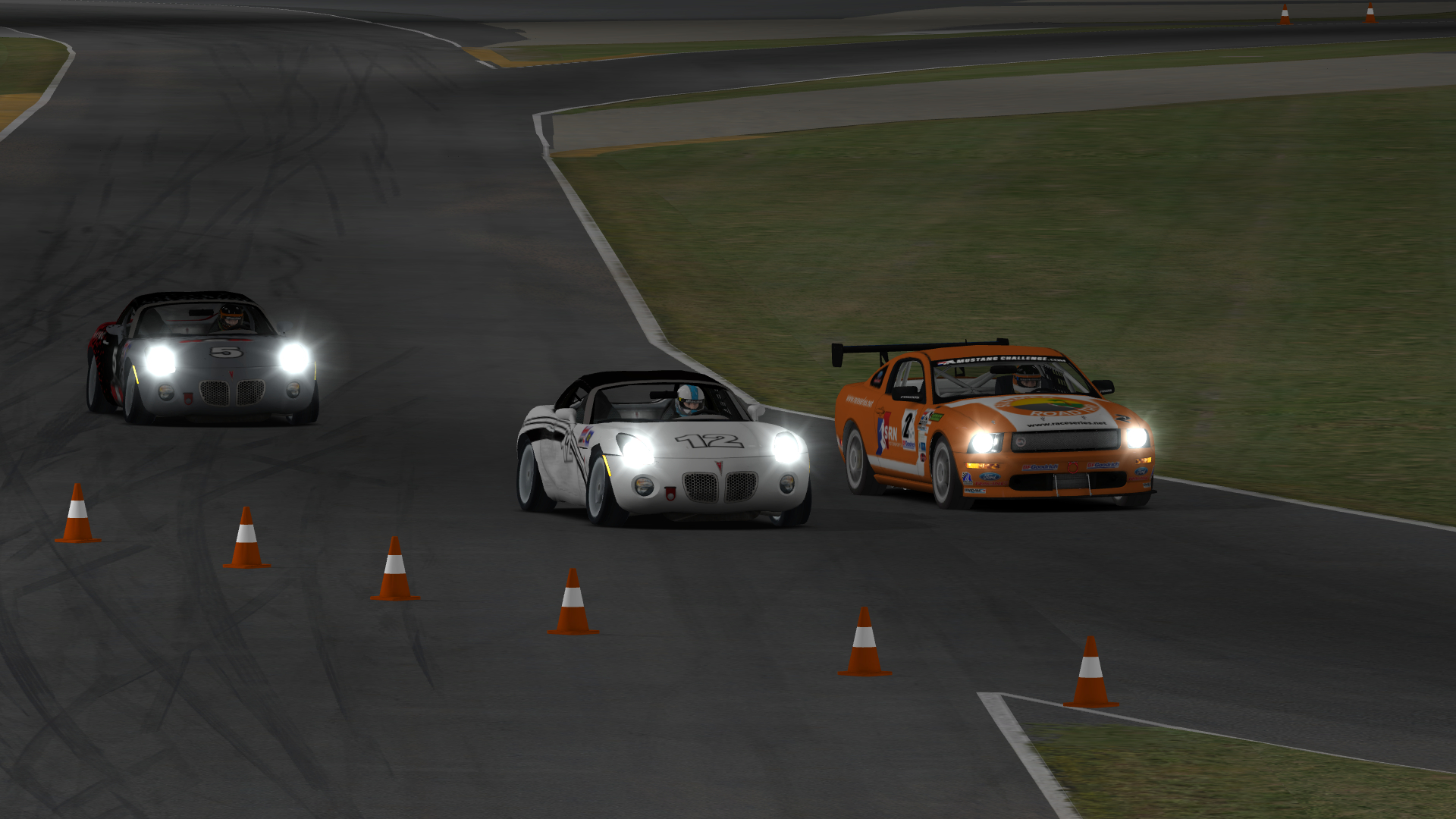
Mustangs easily handle Solstice traffic in the GTC series.
The middle class features the Volkswagen Jetta TDI. It was once a showcase car on iRacing — they held a season-long series that offered the champion a ride in the real-life Jetta TDI Cup. I have always enjoyed driving the Jetta, and when I’ve run the GTC series in the past, it has been my car of choice.
However, as a front-wheel drive, semi-automatic diesel, the Jetta is something of a dead end on the GT racing ladder. Except for perhaps the Kia Optima, it’s souped-up front-wheel drive cousin, no other cars drive much like it.
Because of that, I eschewed the Jetta and jumped into the fastest-class car: the Ford Mustang FR500S. It was formerly the star of the Mustang Challenge series both in real-life and on iRacing. In fact, I competed in the very first Mustang Challenge season when I was just getting started on iRacing, and it’s where I earned my first non-rookie level road racing victory.
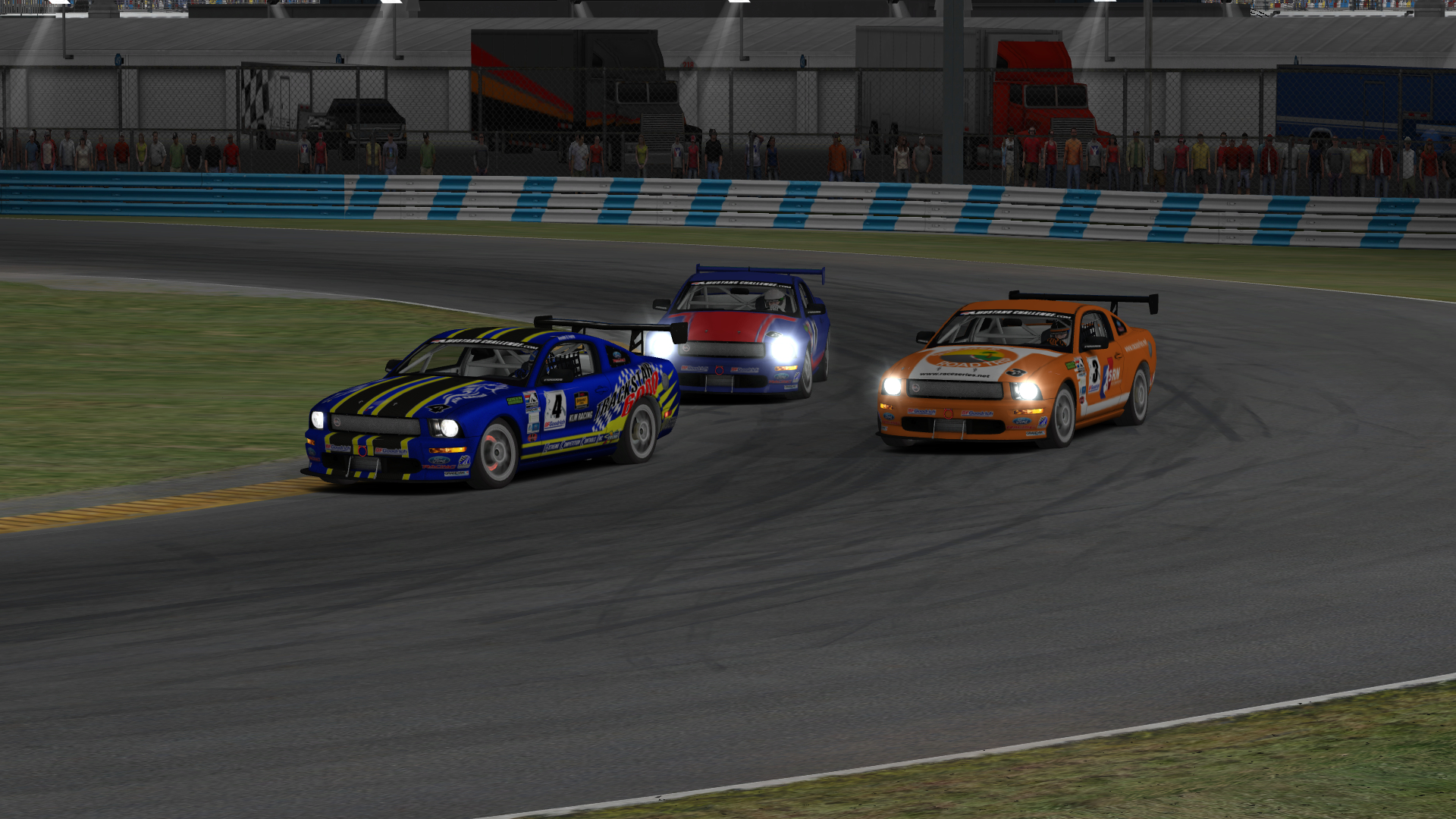
Close competition through the Daytona infield.
The Shakedown
The tire model, transmission physics, and the like have changed since then, but the Mustang is still largely the same car — a roaring V8 with enough power to feel fast and not quite enough downforce to feel glued to the track.
As I prepared for my first race of the week, one veteran Mustang driver in a practice session described the car aptly: “It’s got a lot of weight to it, so it really highlights your mistakes.”
In that sense, the Mustang is the fox to the MX-5’s squirrel: faster in a straight line but less maneuverable in the turns. That makes it a solid step up for new drivers. Like the Mazda, it won’t punish mistakes too harshly, but it will help hone throttle control and steering inputs, especially when oversteer strikes on corner exit.
The Mustang’s available setup adjustments are similar to those offered in the MX-5, so they shouldn’t be too intimidating to new drivers. For those who’d prefer not to tinker with setups, the baseline with fuel removed is a fine starting point, and setups from past seasons that are shared on the forums also work well.
That’s where I found my setup, and other than changing ride heights and fuel levels, I never even touched most of the adjustable settings all week. I suspect most Mustang drivers have one or two tried-and-true setups that work for them, so they largely stick to those without making many changes from week to week.
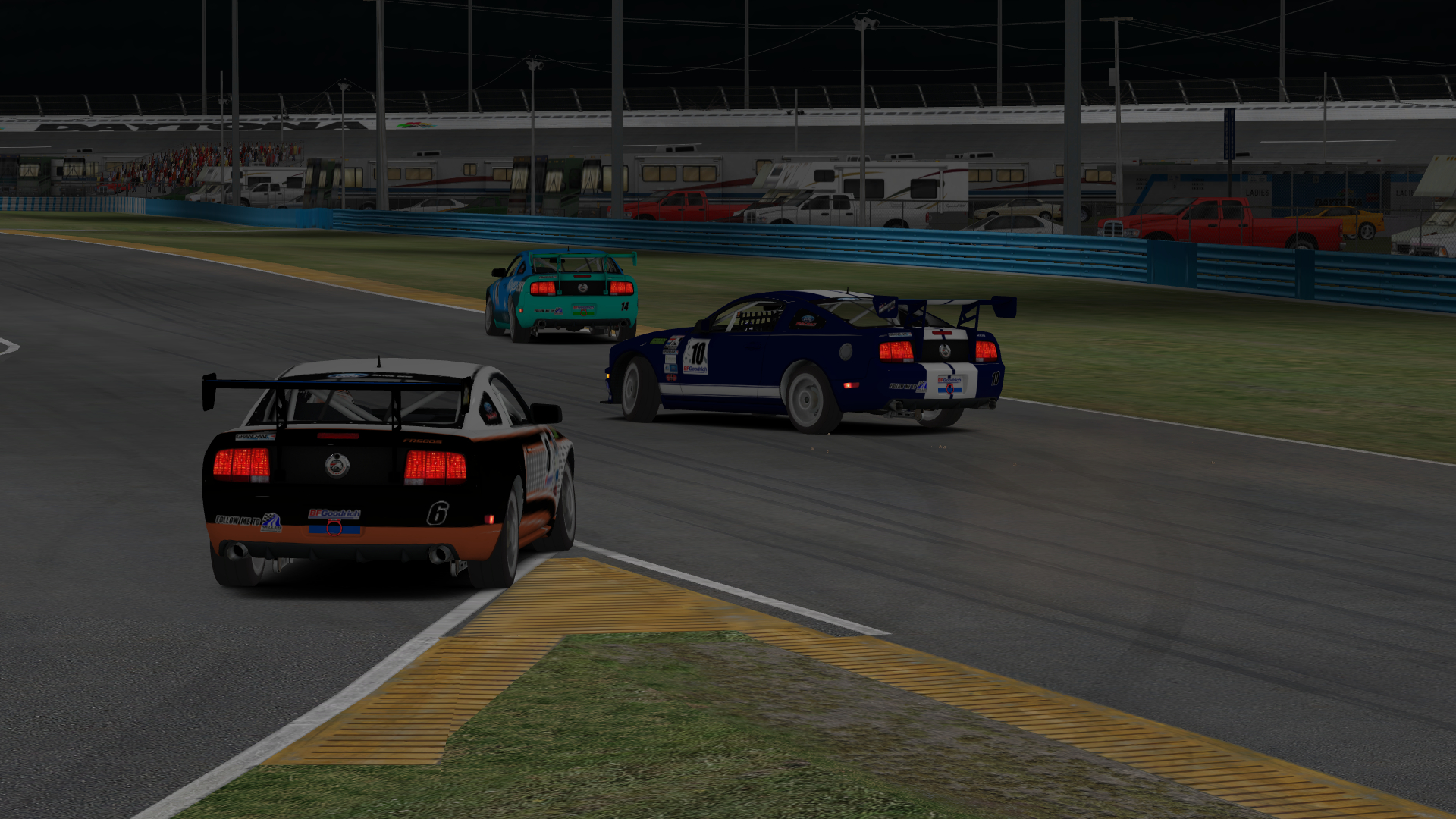
The extra power provided by the Mustang makes exit oversteer an occasional issue.
Know When to Go
Although the Grand Touring Cup series is only one license class above the rookie Global Mazda Cup, the dropoff in participation is significant. Instead of multi-split races 24 hours per day, races often struggle to go official in the every-other-hour timeslot.
I suspect the track had something to do with last week’s low participation. We ran the rarely used motorcycle variant of the Daytona road course, and several drivers I encountered in practice sessions remarked that it was their first time ever driving it.
However, even during week 1 at the wildly popular Watkins Glen, no races had more than one split. That points to an ailment symptomatic of the season: In any series, participation seems to peak in the winter and drop in the summer.
Although seeing race after race fail to go official can be frustrating, that certainly shouldn’t discourage anyone looking to race in GTC. As is the case with most lower-participation series, you just have to know where to look to find an official race.
That’s usually in the iRacing forums, where the community around each series organizes one or more timeslots that tend to have higher and more predictable participation. For the GTC, the 9:15 pm EDT race on Tuesday has been dubbed the Americas Challenge, and unsurprisingly, it had the highest turnout — 30 drivers — of any race all week.
Through the Field
In that race last week, I had plenty of tough competition, including a former winner in the real-world Grand Am KONI Sports Car Challenge series. That made my second-place qualifying run all the more surprising, and it gave me hope that I could keep up with the fast guys in the race.
Unfortunately, my challenge lasted all of one corner. As we headed into the International Horseshoe — the first and only of Daytona’s infield hairpins used on the moto layout — a driver several cars behind me plowed straight through the braking zone and T-boned my car.
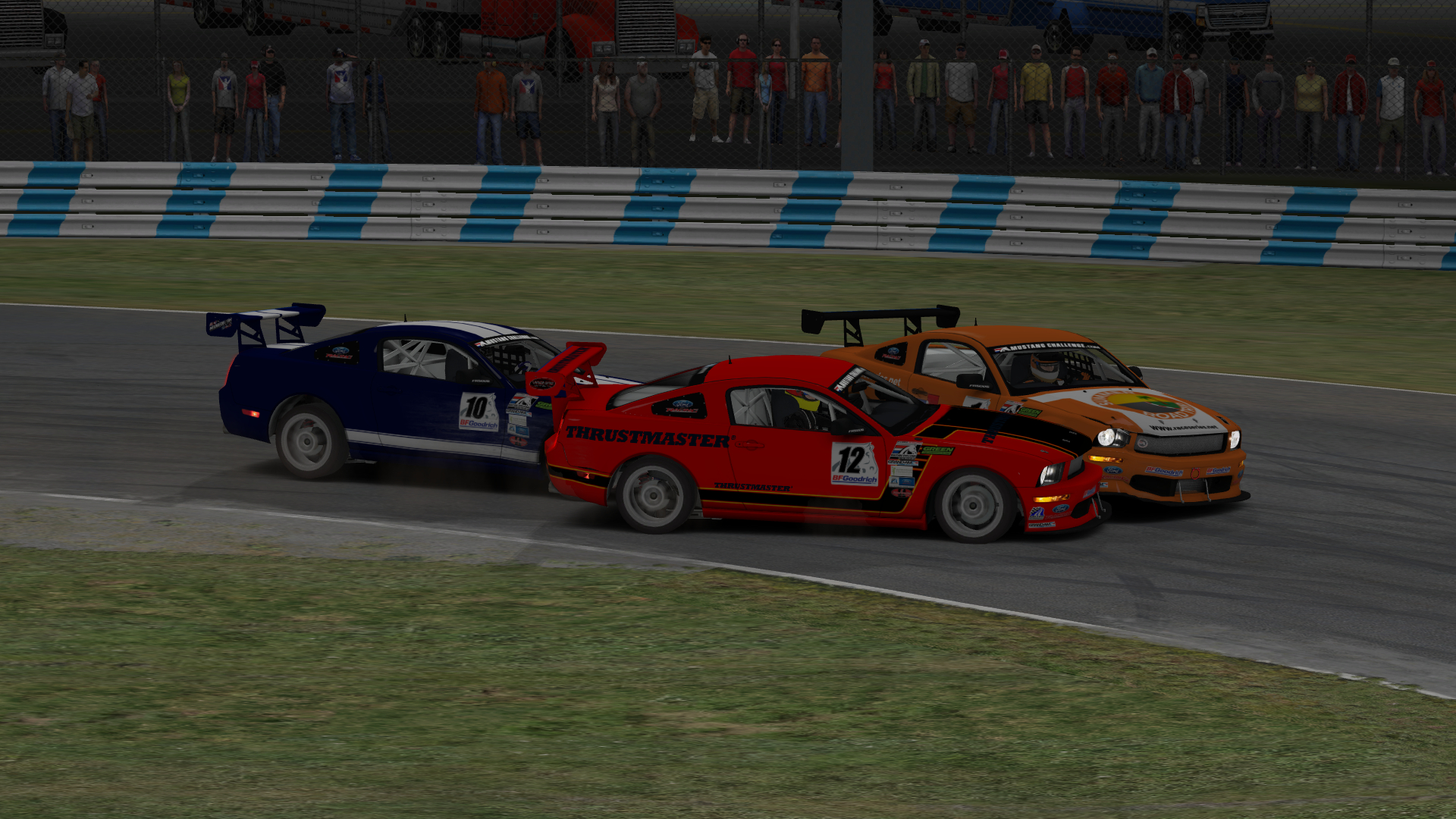
A direct hit in turn 2 ended my chances in the GTC Americas Challenge race.
As I collected my car in the grass, I noticed that the steering wheel was offset — not unexpected given the direct hit to my right front tire. While limping back to the pits, I knew that any chance for a decent finish was gone.
However, I could take advantage of the mulligan offered in low-level series — a free fast repair — and finish the race. Working through the field of slower cars gave me a chance to assess how well the different cars played together.
I encountered the Solstice field first. True to their “Slowstice” nickname, they pose no trouble for the all-around faster Mustangs. The leading Solstices did run up on the slowest Jetta through the slow infield section, but because of the Jetta’s superior straight-line speed, even it has little problem getting away on the straightaways.
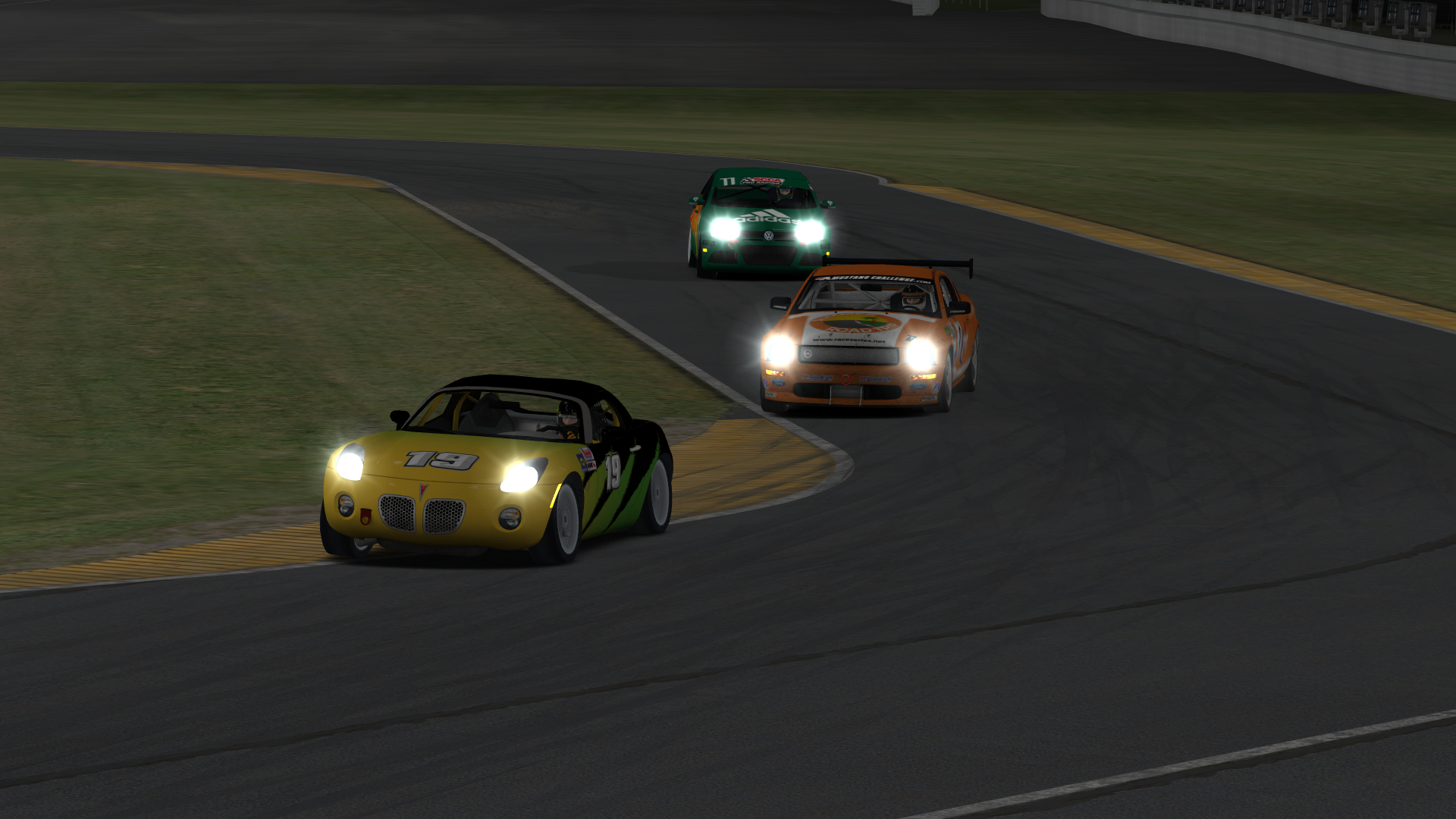
Cars from all three classes weave through the bus stop chicane.
At the front of the Jetta field is where things get a bit more murky. With their lighter weight compared to the Mustangs, the Jettas can brake later and be just as fast through the corners. In my past races in the Jetta, slow Mustang drivers were always a frustration for this reason.
Fortunately, most drivers I encountered on-track this week were surprisingly aware of their surroundings, and slower drivers tended to give way to faster cars and closer battles behind them. That’s not always a given in a low-level series, but it shows that the GTC is a great place to learn multiclass racing awareness.
By the end of my race, I had carved through the slower classes and passed a few backmarker Mustangs, but as the top driver by iRating in the field, there was little else to salvage with a ninth-place finish.
Grand Touring Cup - Race 1
Tuesday, June 20 at 9:15 pm EDT • Strength of Field: 2400| Finish | Start | Interval | Laps Led | Fastest Lap | Incidents | Points | iRating | Safety Rating |
|---|---|---|---|---|---|---|---|---|
| 9 | 2 | -59.619 sec. | 0 | 1:50.741 | 7 | 54 | 4425 (-66) | A 4.08 (-0.19) |
Second Chances
After that race, it took nearly three days to find another official race in US prime time hours. On Friday evening, the participation was finally strong enough to get in a couple of races. Although the turnout — 12 drivers in the first race, 13 in the second — wasn’t as high as on Tuesday night, there was still a solid mix of fast and slow drivers throughout the field.
In the first race, I started on the pole but was passed for the lead just after the midway point. My competitor and I, it seemed, had similar overall pace, but we found it in different places. I was quick through the tight infield section, but I couldn’t match his runs back onto the oval or through the bus stop chicane.
Even with some aid from the draft, I couldn’t quite close up to him on the oval, so he was able to hold me off and win by a car length.
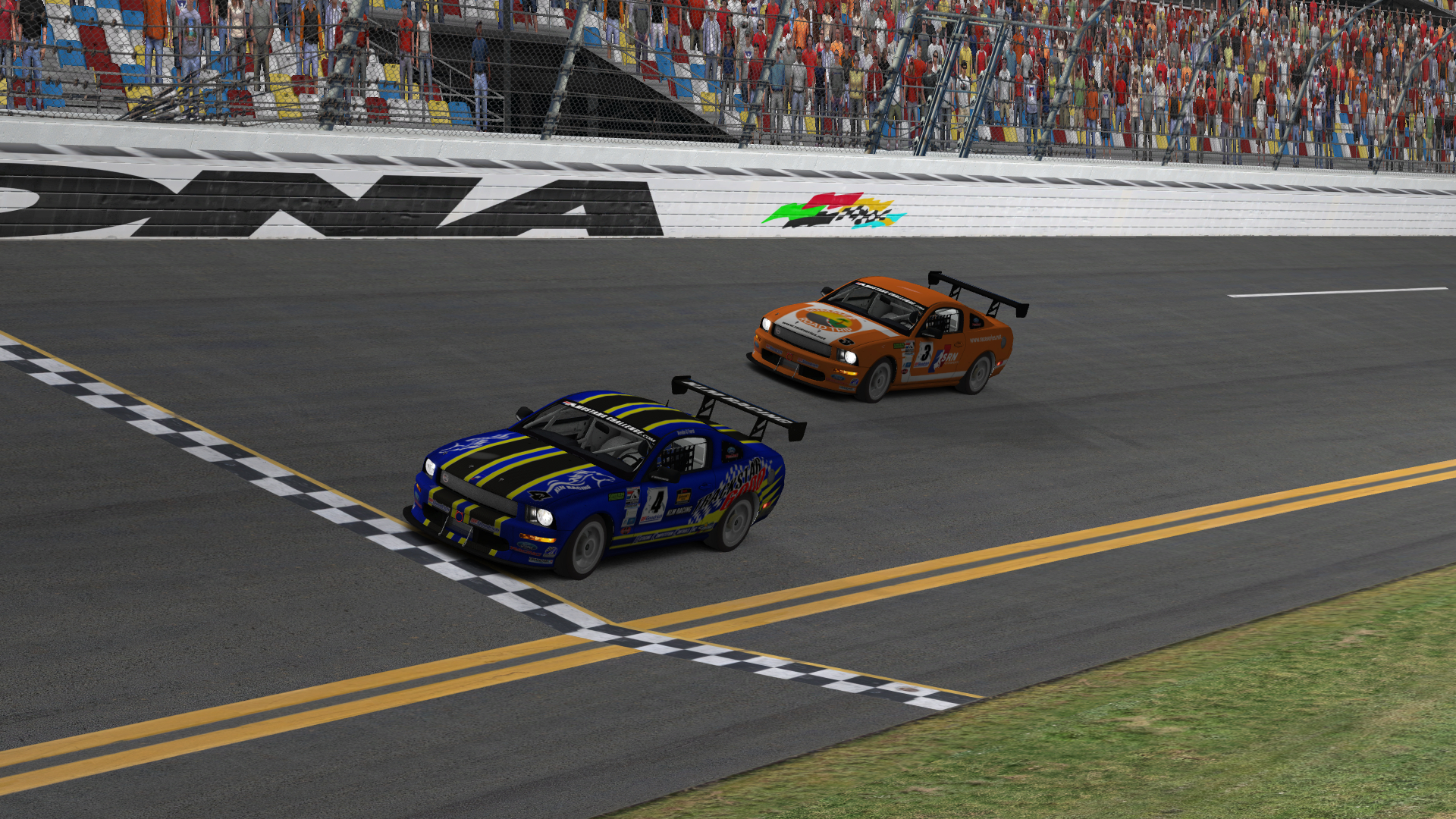
A close finish to my second race of the week.
Grand Touring Cup - Race 2
Friday, June 23 at 5:15 pm EDT • Strength of Field: 3245| Finish | Start | Interval | Laps Led | Fastest Lap | Incidents | Points | iRating | Safety Rating |
|---|---|---|---|---|---|---|---|---|
| 2 | 1 | -0.167 sec. | 8 | 1:49.664 | 2 | 114 | 4444 (+19) | A 4.07 (-0.01) |
In my other Friday night race, I qualified second behind an opponent I’ve dueled with before, but in a different car. Several years ago, I defeated him in the Jetta around Monza. While he was nearly a second faster than me in qualifying with the Mustang, it seemed possible that another draft battle could play out between us at Daytona.
His pace was clear, and he nearly broke my draft before being slowed by traffic in the bus stop, which let me close back in on him. Otherwise, it was a similar story as in the previous race: I just couldn’t match his runs onto the oval, which kept me far enough behind to keep me from challenging for the victory.
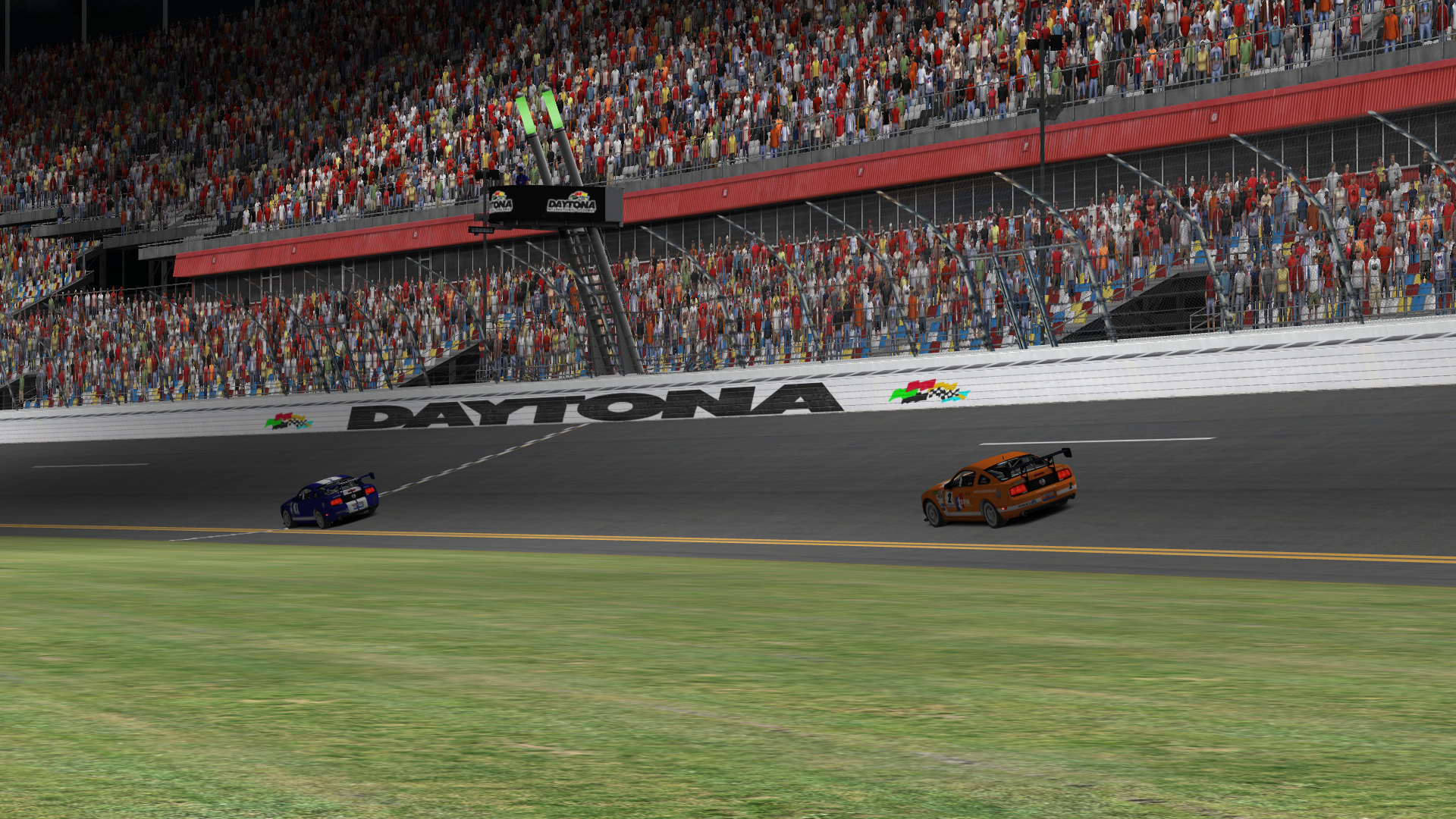
Another narrow defeat in my third race of the week.
Grand Touring Cup - Race 3
Friday, June 23 at 9:15 pm EDT • Strength of Field: 1607| Finish | Start | Interval | Laps Led | Fastest Lap | Incidents | Points | iRating | Safety Rating |
|---|---|---|---|---|---|---|---|---|
| 2 | 2 | -0.589 sec. | 0 | 1:49.892 | 2 | 77 | 4448 (+4) | A 4.08 (+0.01) |
Ready for a Rematch
I also wanted to run a weekend race since in many series, that’s when the fields are the biggest and strongest. However, throughout the day on Saturday, I again struggled to find official races, other than one attended by a pack of Solstices but no Mustangs.
By the afternoon, a timeslot finally attracted a solid turnout, so I signed up and found my first opponent from the previous day in the race as well. That meant it was time for a rematch, and I hoped I could reverse the result.
This time, we also had a third close competitor who stayed in the mix early until he spun near the midway point. After that, it was down to another a one-on-one battle, and it became my closest and most competitive of the week.
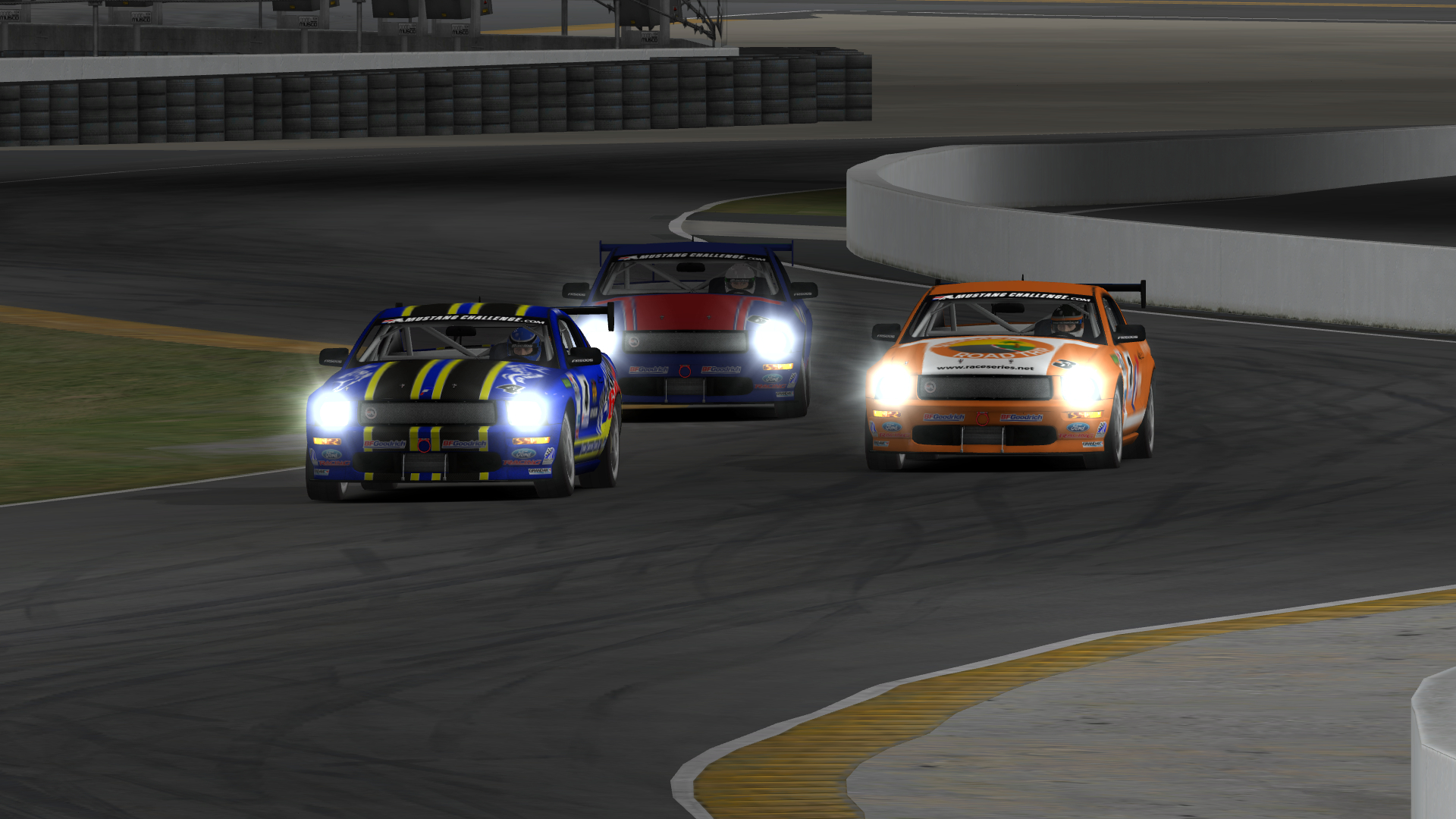
A three-way Mustang battle heads through the esses.
Several times, our bumpers were just inches apart as we traversed the infield, often weaving through traffic at the same time. Fortunately, I felt comfortable enough racing him and driving the Mustang to keep it so close, and ultimately, I had to stay right on his bumper if I hoped to keep up with him on the oval.
I knew the bus stop would still be my make-or-break corner, so I tried just about everything imaginable to get through there faster. I braked early, I braked late, and I even clipped the dirt beyond the kerbs to straight-line the exit at the risk of an off-track penalty.
Twice in the closing laps, he was slowed by traffic entering the chicane, which let me get a run onto the banking and enter turn one side-by-side. Each time, though, he managed to make the inside line work and retain the lead.
The final lap felt hauntingly familiar. For the third race in a row, as we exited the bus stop, I was well within drafting range but not close enough to get alongside by the start-finish line.
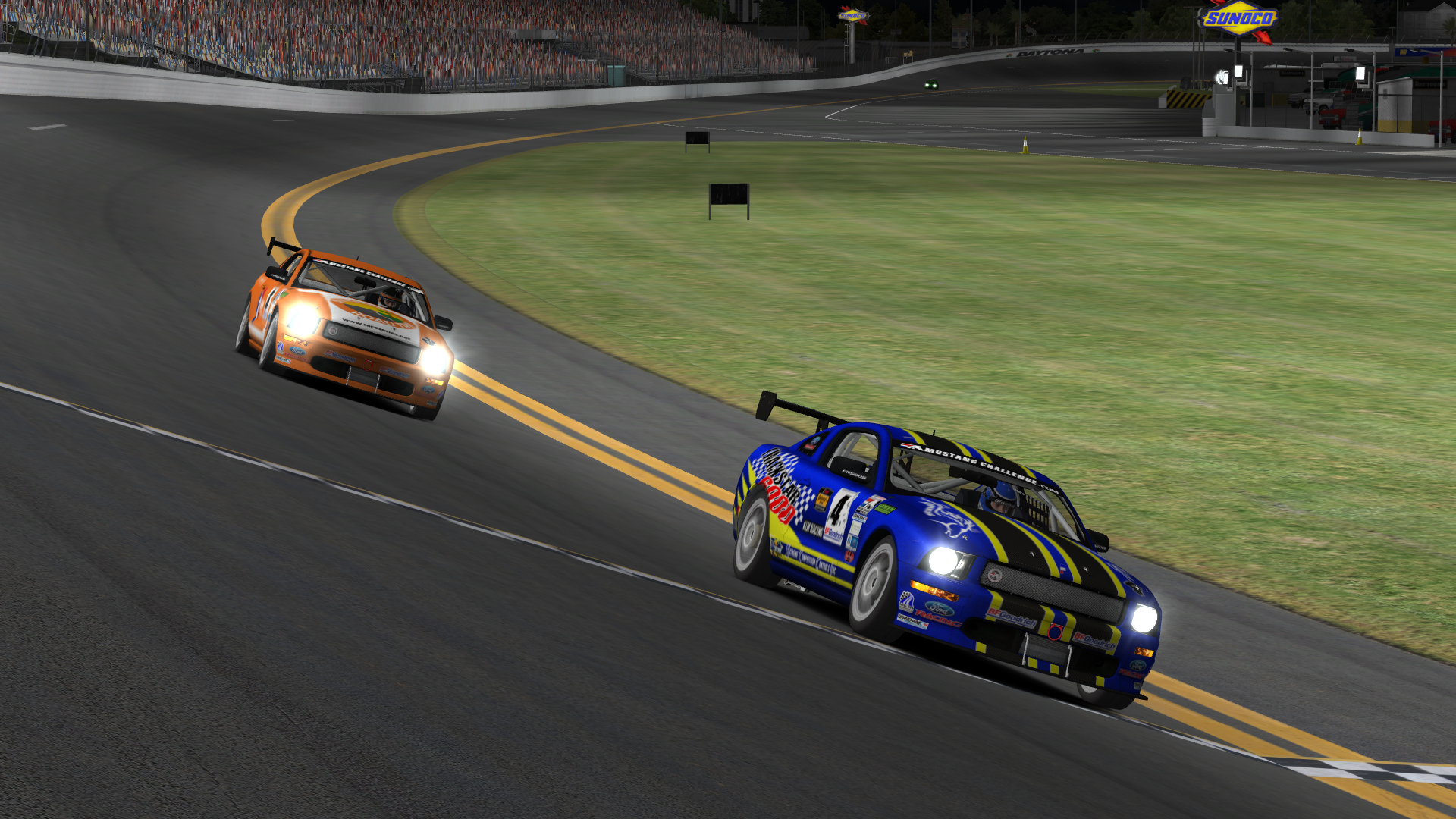
Second place yet again in my final duel at Daytona.
Grand Touring Cup - Race 4
Saturday, June 24 at 5:15 pm EDT • Strength of Field: 2190| Finish | Start | Interval | Laps Led | Fastest Lap | Incidents | Points | iRating | Safety Rating |
|---|---|---|---|---|---|---|---|---|
| 2 | 2 | -0.243 sec. | 6 | 1:49.684 | 2 | 97 | 4459 (+11) | A 4.09 (+0.01) |
A Great Place to Race
For me, there was no shame in finishing second in any of those races. Both competitors were worthy and respectful opponents with lots of experience in the Mustang, so just keeping up as well as I did was an achievement.
But losing three races by a combined margin of one second was slightly agonizing, especially since it highlighted my consistent inadequacy through just one or two corners. As a driver, that’s a bit like having your flaws on full display.
Ultimately, I hope that my memento from this leg of the Summer Road Trip won’t be my Sisyphean inability to get to the top. Instead, after underperforming in the Mazda compared to drivers around my iRating, I’m happy that I was competitive with them this week.
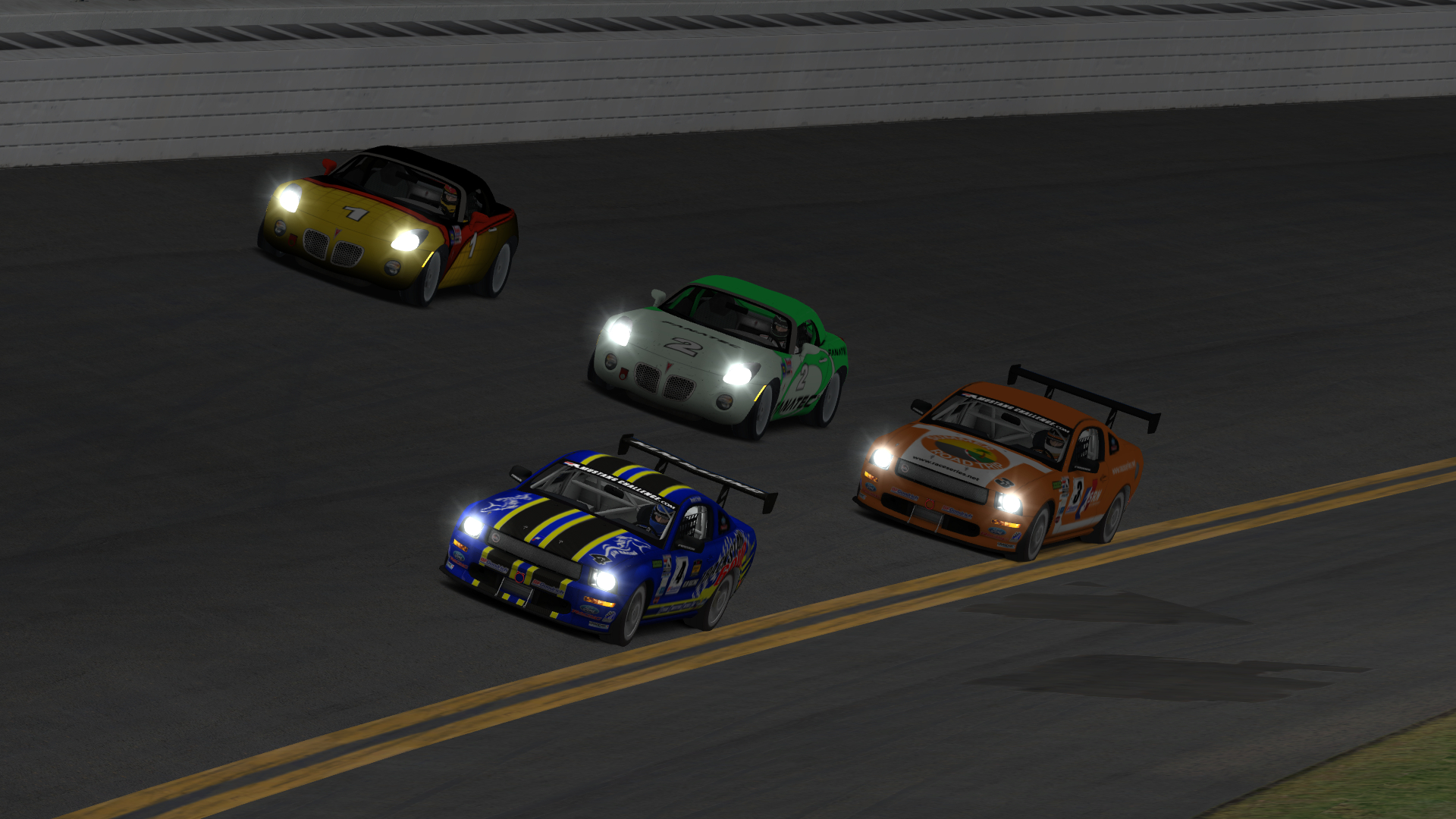
Racing three-wide on the banking with the Solstice leaders.
I’m also pleased to see the state of the GTC series, the summer participation lull aside. This series could easily have an identity crisis with its hodgepodge of cars and drivers of so many different skill levels.
Instead, I’ve found a friendly atmosphere with veterans willing to share setups and tips, rookies willing to learn, and nearly all drivers being patient and aware of their surroundings on the track.
For aspiring tintop racers, the Grand Touring Cup series is a key step on the development ladder. Of course, the appeal of modern, flashy GT machinery means many drivers jump straight into those cars, forgoing the fundamentals of swimming in the shallow end for the thrill — and risk — of diving in deep.
As I prepare to test the waters of those series beginning this week in the Porsche at Watkins Glen, I can only hope that my dive isn’t a bellyflop, and that another bus stop doesn’t haunt me once more.